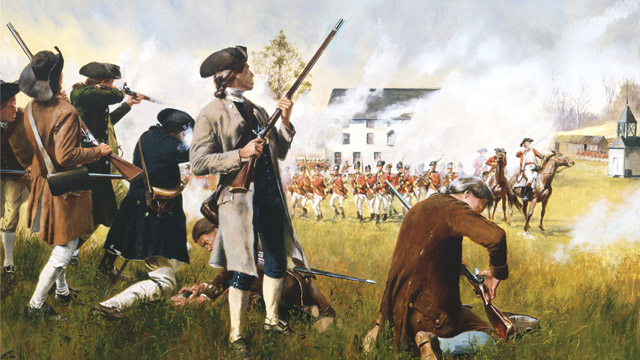
4th of July Ceremony to Honor First Resident Killed in Battle
by Michael Perrone
Belleville Historical Society
Last September an out of state visitor contacted the Belleville Historical Society and requested a tour of the historic Belleville Dutch Reformed Church cemetery, the final resting place of sixty-six Revolutionary War soldiers. In colonial times the church was know as the old Dutch Church of Second River. Belleville was then known as Second River and included parts of Nutley and Bloomfield. The visitor was the 5x great grand daughter of Henry Brown. Henry Brown served as a Lieutenant in the 1st Regiment of the Essex County Militia and is buried in the Dutch Church cemetery. The Historical Society was then provided with contact information for other Brown family members who could provide greater details on the family history. The results of several months of correspondence with Brown’s descendants and research at the New Jersey Historical Society is making this year’s 4th of July especially meaningful.The Belleville Historical Society has now documented the presence of a previously unknown Revolutionary War soldier in the cemetery. He is the first one known to have been killed in battle. Private Hermanus Brown now becomes the sixty-seventh known to be buried here and probably the youngest, giving his life for our new country in June of 1780 at age 18. Brown lived in the Spring Garden Nutley section of Second River.
Under the cover of darkness, shortly after midnight on June 7, 1780, the colony of New Jersey was invaded by a massive army from New York. Commanded by German General Wilhelm von Knyphausen, the force of 3,000 German and 3,000 British soldiers landed in Elizabeth. For the record the Germans usually referred to as “Hessians mercenaries”- were not. That was a deragatory term used by Thomas Jefferson in writing the Declaration of Independence.The Germans were from the German province of Hesse as well as half a dozen other German kingdoms. They were all allies of Great Britain by treaty. They were regular German armies, fighting under German generals and German flags. King George himself, although born in England, was of German descent and was at the same time both King of England and prince of the German kingdom of Hanover. So American troops have been dealing with Germans long before Normandy and the Battle of the Bulge.
In the spring of 1780 General von Knyphausen believed he had the opportunity to destroy George Washington and his army at Morristown. The winter of 1780 had been the most severe in 100 years. The Continental Army had been devastated by the cold, disease, lack of food and desertion. Von Kynphausen’s spies assured the general that Washington’s army was about to mutiny. Von Kynphausen was confident that he would be the one to finally put an end to the American rebellion. The march from Elizabeth to Morristown was expected to be swift with little local resistance. However shortly after the invaders landed, they were spotted by American scouts. Riders were sent out to alert Washington at Morristown and to call in the Essex and Morris County Militias. The Second River (Belleville) Dutch Reformed Church served as the local military headquarters. The mostly Dutch village of Second River was a patriot stronghold. A guard was kept in the church steeple along with an old mortar (left over from the French and Indian War) to be fired if needed to summon the militia. The blast of the mortar in the middle of the night sent the men scurrying out of their beds and reaching for their muskets and powder horns. The church bells began to ring and the hundred men of the militia formed ranks quickly. Among them was Lieutenant Henry Brown, his 18 year old son Hermanus “Manus” who had just joined the militia, and Henry’s cousins Issac and John Brown. The company marched off under orders of Brigadier General Philip van Cortlandt, commanding officer of the Essex County Militia, to take up positions at Connecticut Farms (Union).
At 9 am on the morning of June 7, the enemy appeared and the militiamen engaged in what would be a furious three hour battle. Greatly outnumbered and outgunned the Americans withdrew into the woods but they had successfully halted General Knyphausen’s advance. Later that afternoon George Washington and the Continental Army arrived and planned a counteroffensive. Von Knyphausen was surprised and concerned by the stiff American resistance and the growing number of militia reinforcements arriving. He decided to order a retreat of his troops back to Elizabeth. General Washington issued an order that three regiments were to pursue the enemy from three different positions. General van Cortlandt was to take the Essex County Regiment and attack from the left flank, with the Continental Army and the Morris militia taking the center and right flanks.
The Americans pursued the retreating enemy across a sweeping meadow. Unknown to the Americans, hidden in the woods at the end of the meadow the enemy had set up a line of artillery to cover their retreat. As the militiamen and Continentals charged across the fields a barrage of cannon fire rained down on them from the woods. Private Hermanus Brown musket in hand, bravely charged across the open field towards and against the worlds most powerful army. The youthful Brown must have felt like fellow militiaman Ashbed Green, who described the fiery charge across the meadow, writing in his diary, “no thunderstorm I have ever witnessed, either in loudness of sound or the shaking of the earth, equaled what I saw and felt in crossing that meadow”. As the pursuit continued, in the hail of cannonballs, tragically one found its mark and tore into the young patriot killing him instantly. Hermanus Brown’s brief military career ended on a battlefield just twelve miles from his home.
Von Knyphausen and his men set up their camp in Elizabeth. Meanwhile the Americans gathered their wounded and dead. The dead were always buried on the battlefield. That is unless they were close enough to home and there was someone to return the body. As fate would have it, Hermanus’ father and cousins were there in the heat of the battle, therefore providing them with the sad opportunity of returning his body home for a proper burial. Private Hermanus Brown was buried in the cemetery of the Dutch church where he had been baptized eighteen years earlier on a cold December morning. His burial, probably on June 9, 1780 would have been the town’s first military funeral. The tombstone, set shortly after his death read, “Hermanus, son of Henry and Rachel Brown, died, 8 June, 1780, in the 18 year of his age”. The stone bore an epitagh that read “Behold me here, as you pass by, Who died for Liberty, From British tyrants now I’m free, My friends prepare to follow me”. Private Brown’s tombstone was destroyed by British Loyalists. The war continued for three more years after his death. Private Hermanus Brown was the first known soldier of Nutley to give his life in service to his new country. Just a few months after enlisting he was killed in his first battle. He now rests with sixty-six other Revolutionary War soldiers in the old Dutch church yard where their honored remains are remembered and celebrated everyday and especially on the morning of the 4th of July.
The Belleville Historical Society will dedicate an historically accurate new monument to Private Hermanus Brown at the old Belleville Dutch Reformed Church at 10am July 4th. Our annual Salute to America’s First Troops will include the Roll Call of the Regiment, readings from the Declaration of Independence, Raising of the Colors, the National Anthem and conclude with the firing of a 21 gun cannon salute. We invite all to attend this unique opportunity to spend the 4th of July morning with the men who were there when it all began. Few Americans have an opportunity such as this. There were only 13 colonies at the time, no other states ever saw the American Revolution. More than half the battles of the war were fought in New Jersey. And the soldiers of Belleville and Nutley fought under the command of George Washington at the battles of Connecticut Farms and Monmouth as well as others. Please join us on the morning of July 4th.
For more information about the July 4th morning ceremony contact Michael Perrone at 973-780-7852 or email Bellevillehistory@gmail.
Update: These are some photos that I took from last year’s ceremony posted on the Nutley Watch Facebook page:
Belleville 4th of July Cannon Ceremony 2014
Update (7/2): A copy of the article has been published on NorthJersey.com:
Young Nutley soldier among those buried at Belleville church
Update (7/11): Here is our coverage of the 4th of July event at the Dutch Reformed Church:
Belleville and Nutley Celebrate Their Common Heritage on July 4th


Be the first to comment